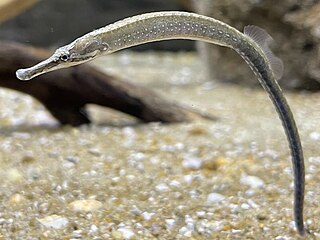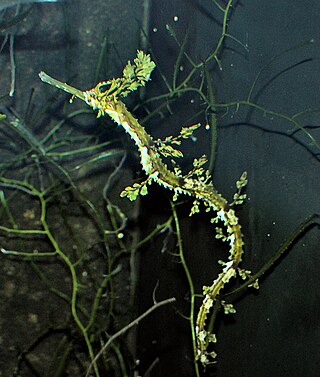
A seahorse is any of 46 species of small marine bony fish in the genus Hippocampus. "Hippocampus" comes from the Ancient Greek hippókampos (ἱππόκαμπος), itself from híppos (ἵππος) meaning "horse" and kámpos (κάμπος) meaning "sea monster" or "sea animal". Having a head and neck suggestive of a horse, seahorses also feature segmented bony armour, an upright posture and a curled prehensile tail. Along with the pipefishes and seadragons they form the family Syngnathidae.

The leafy seadragon or Glauert's seadragon, is a marine fish. It is the only member of the genus Phycodurus in the family Syngnathidae, which includes seadragons, pipefish, and seahorses.
Sea Dragon or seadragon may refer to:

The Syngnathidae is a family of fish which includes seahorses, pipefishes, and seadragons. The name is derived from Ancient Greek: σύν, meaning "together", and γνάθος, meaning "jaw". The fused jaw is one of the traits that the entire family have in common.

The common seadragon or weedy seadragon is a marine fish of the order Syngnathiformes, which also includes the similar pipefishes, seahorses, and trumpetfishes among other species. Adult common seadragons are a reddish colour, with yellow and purple striped markings; they have small, leaf-like appendages that resemble kelp or seaweed fronds, providing camouflage, as well as a number of short spines for protection. As with seahorses and the other syngnathids, the seadragon has a similarly tubular snout and a fused, toothless jaw into which it captures small invertebrate prey at lightning speed. Males have narrower bodies and are darker than females. Seadragons have a long dorsal fin along the back and small pectoral fins on either side of the neck, which provide balance. Weedy seadragons can reach 45 cm (18 in) in length.

Male pregnancy is the incubation of one or more embryos or fetuses by organisms of the male sex in some species. Most species that reproduce by sexual reproduction are heterogamous—females producing larger gametes (ova) and males producing smaller gametes (sperm). In nearly all animal species, offspring are carried by the female until birth, but in fish of the family Syngnathidae, males perform that function.

Pipefishes or pipe-fishes (Syngnathinae) are a subfamily of small fishes, which, together with the seahorses and seadragons, form the family Syngnathidae.

Underwater World, also known as Underwater World Singapore Pte Ltd, was an oceanarium located on the offshore Singaporean island of Sentosa. It was opened on 13 May 1991 and closed on 26 June 2016.

The Aquarium of Western Australia (AQWA) is a privately owned aquarium in Hillarys, Western Australia. Located approximately 20 km (12 mi) north-west of Perth City, it is a popular attraction for tourists and locals alike.

Ruby is a color that is a representation of the color of the cut and polished ruby gemstone and is a shade of red or pink.

Rhinopias frondosa, the weedy scorpionfish or the weed fish, is a species of marine ray-finned fish belonging to the family Scorpaenidae, the scorpionfishes. This species is found in the Indo-West Pacific. It is a rare but highly desirable fish in the aquarium trade.

The Hippocampinae are a subfamily of small marine fishes in the family Syngnathidae. Depending on the classification system used, it comprises either seahorses and pygmy pipehorses, or only seahorses.

The Pacific seaweed pipefish is a species of pipefish, which is a marine, oceanic demersal fish, common in the beds of Zostera sea grass. The pipefish is well known for being one of the most famous and expensive materials of Traditional Chinese medicine, as it possesses a special medicinal composition. The fish is a member of the Syngnathidae family, making them relatives with seahorses and seadragons. The Syngnathidae family is a large group with almost 300 species of marine, brackish, and freshwater fish.

The ribboned pipefish, ribboned pipehorse or ribboned seadragon, is a species of pipefish found along the coast of northern Australia and New Guinea in habitats ranging from shallow and weedy to deeper and sandy bottoms down to depths of 16.5 m (54 ft). This species grows to a total length of 30 cm (12 in). Their colors can range from greenish yellow to brownish red. This species is the only known member of its genus.
The upside-down pipefish is a species of pipefish endemic to the coasts of southern Australia, from New South Wales to Geographe Bay in Western Australia, where it is found in rocky reefs at depths of from 2 to 15 metres. It grows to a length of 9.2 centimetres (3.6 in) SL. This species is the only known member of its genus. Like other pipefish it is ovoviviparous but it may breed seasonally, as gravid males have been collected between September and November.
The ruby seadragon is a marine fish in the family Syngnathidae, which also includes seahorses. It inhabits the coast of Western Australia. The species was first described in 2015, making it only the third known species of seadragon, and the first to be discovered in 150 years. A specimen found on shore in 2007 was 23.5 cm (9.3 in) long.

The Great Southern Reef is a system of interconnected reefs that spans the southern coast of continental Australia and Tasmania and extends as far north as Brisbane to the east and Kalbarri to the west. It covers 71,000 km2 (27,000 sq mi) of ocean and straddles five states, running along the coast for 8,000 km (5,000 mi).

Nerida Gaye Wilson is an invertebrate marine molecular biologist at the Commonwealth Scientific and Industrial Research Organisation who has interests in diversity, systematics, phylogeny, phylogeography and behavior. Wilson has been instrumental in demonstrating the level of marine cryptic species complexes in Antarctic waters, testing the circumpolar distribution paradigm with molecular data, and using interdisciplinary approaches to show how Antarctic diversity may have been generated. Her work with NOAA on Antarctic Marine Living Resources has been used to regulate exploratory benthic fisheries.
Leafy seadragons are widely recognized for their strikingly derived characters, including leaf-like appendages, extreme spinal curvature, elongated craniofacial bones, and large body size. These make them phenotypic outliers in the teleost fish clade . Up until recently, the genome of leafy seadragons was unknown; but in 2022, their genome was fully annotated, along with weedy seadragons. Several significant features have been found in the leafy seadragon and weedy seadragon genomes, including divergent noncoding regions near a developmental gene responsible for integumentary growth; high genome wide repetitive DNA density; and recent transposable element expansions. Genetic diversity in leafy seadragons and weedy seadragons is relatively low as they have low-dispersal life history. Most recently, another species of seadragon was discovered and genetically sequenced: the ruby seadragon, which differs genetically and phenotypically from the two other seadragon species.















